HI6028 Taxation Theory: Partnership Tax Return & Fringe Benefits
VerifiedAdded on 2023/04/21
|8
|1622
|418
Report
AI Summary
This assignment solution provides a detailed analysis of taxation principles, focusing on partnership tax returns and fringe benefit tax (FBT) implications. It begins with a computation of net income from a partnership business owned by Daniel and Olivia Smith, considering cash and credit sales, purchases, and depreciation of assets, adhering to Australian Tax Office (ATO) guidelines. The net income is calculated, factoring in allowable deductions and depreciation. The second part delves into fringe benefits, explaining their nature and taxability under Australian law, particularly the Fringe Benefit Act of 1986. It examines a case involving an employee, John, who receives educational assistance and housing from his employer, determining the FBT implications and calculating the taxable value of the housing benefit based on market value versus employee contribution.
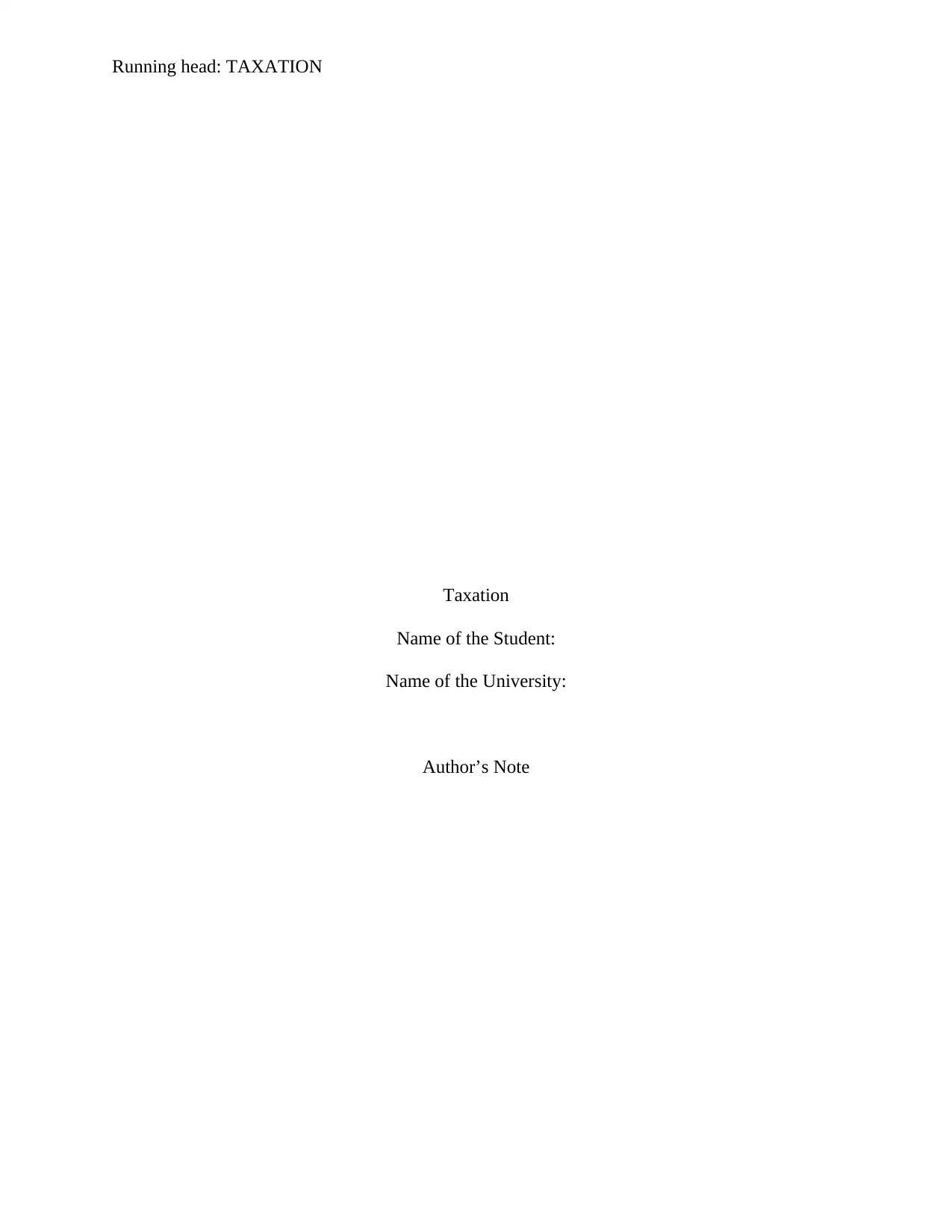
Running head: TAXATION
Taxation
Name of the Student:
Name of the University:
Author’s Note
Taxation
Name of the Student:
Name of the University:
Author’s Note
Paraphrase This Document
Need a fresh take? Get an instant paraphrase of this document with our AI Paraphraser
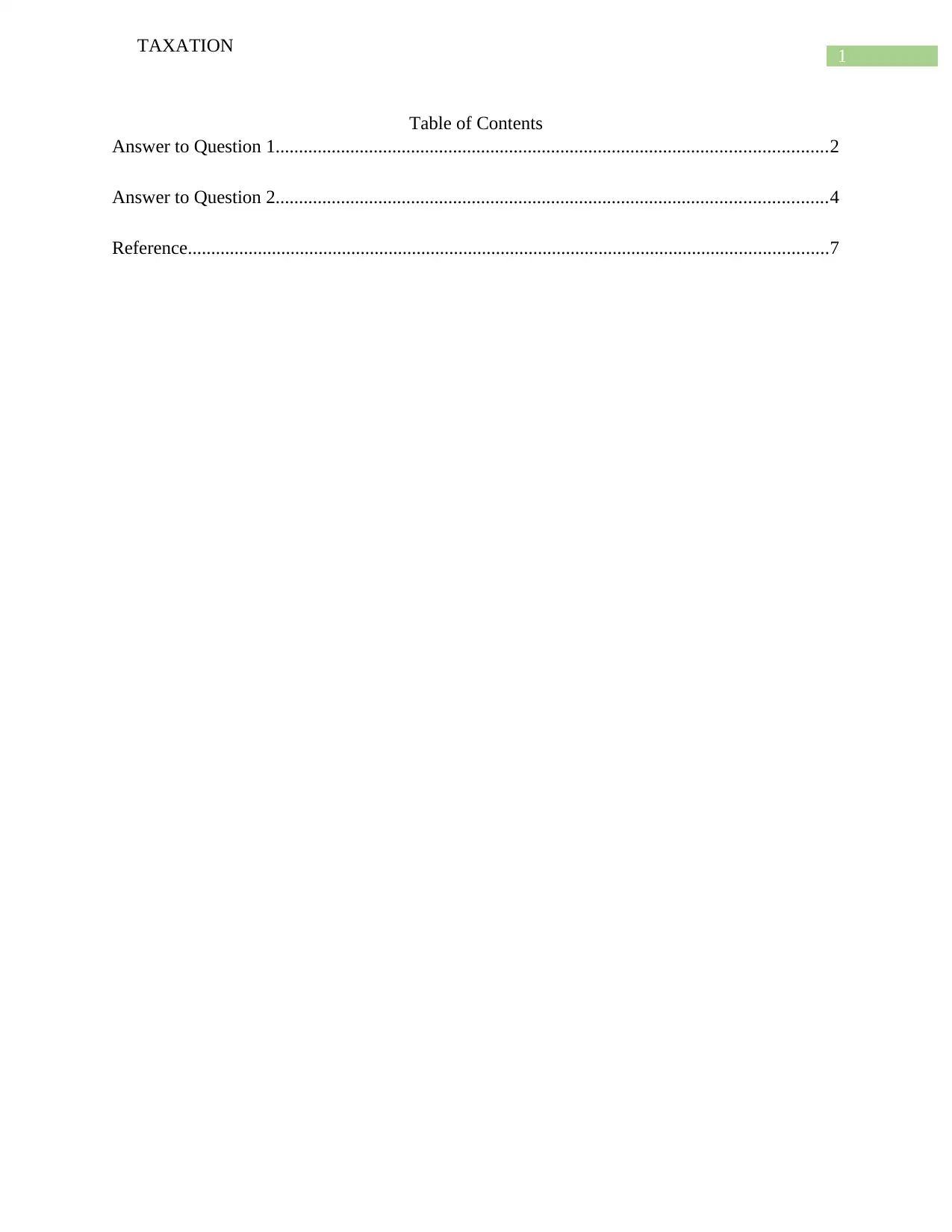
1
TAXATION
Table of Contents
Answer to Question 1......................................................................................................................2
Answer to Question 2......................................................................................................................4
Reference.........................................................................................................................................7
TAXATION
Table of Contents
Answer to Question 1......................................................................................................................2
Answer to Question 2......................................................................................................................4
Reference.........................................................................................................................................7
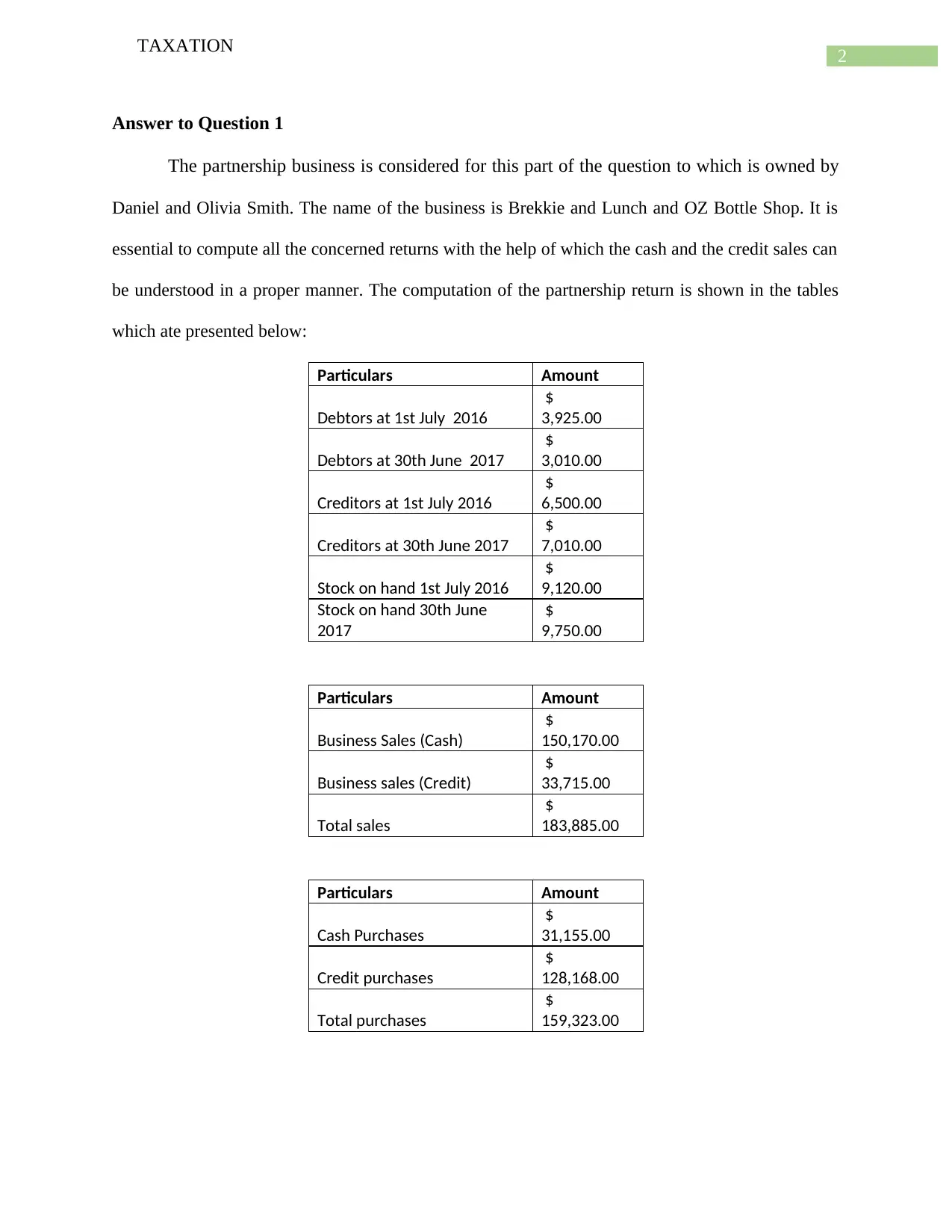
2
TAXATION
Answer to Question 1
The partnership business is considered for this part of the question to which is owned by
Daniel and Olivia Smith. The name of the business is Brekkie and Lunch and OZ Bottle Shop. It is
essential to compute all the concerned returns with the help of which the cash and the credit sales can
be understood in a proper manner. The computation of the partnership return is shown in the tables
which ate presented below:
Particulars Amount
Debtors at 1st July 2016
$
3,925.00
Debtors at 30th June 2017
$
3,010.00
Creditors at 1st July 2016
$
6,500.00
Creditors at 30th June 2017
$
7,010.00
Stock on hand 1st July 2016
$
9,120.00
Stock on hand 30th June
2017
$
9,750.00
Particulars Amount
Business Sales (Cash)
$
150,170.00
Business sales (Credit)
$
33,715.00
Total sales
$
183,885.00
Particulars Amount
Cash Purchases
$
31,155.00
Credit purchases
$
128,168.00
Total purchases
$
159,323.00
TAXATION
Answer to Question 1
The partnership business is considered for this part of the question to which is owned by
Daniel and Olivia Smith. The name of the business is Brekkie and Lunch and OZ Bottle Shop. It is
essential to compute all the concerned returns with the help of which the cash and the credit sales can
be understood in a proper manner. The computation of the partnership return is shown in the tables
which ate presented below:
Particulars Amount
Debtors at 1st July 2016
$
3,925.00
Debtors at 30th June 2017
$
3,010.00
Creditors at 1st July 2016
$
6,500.00
Creditors at 30th June 2017
$
7,010.00
Stock on hand 1st July 2016
$
9,120.00
Stock on hand 30th June
2017
$
9,750.00
Particulars Amount
Business Sales (Cash)
$
150,170.00
Business sales (Credit)
$
33,715.00
Total sales
$
183,885.00
Particulars Amount
Cash Purchases
$
31,155.00
Credit purchases
$
128,168.00
Total purchases
$
159,323.00
⊘ This is a preview!⊘
Do you want full access?
Subscribe today to unlock all pages.

Trusted by 1+ million students worldwide
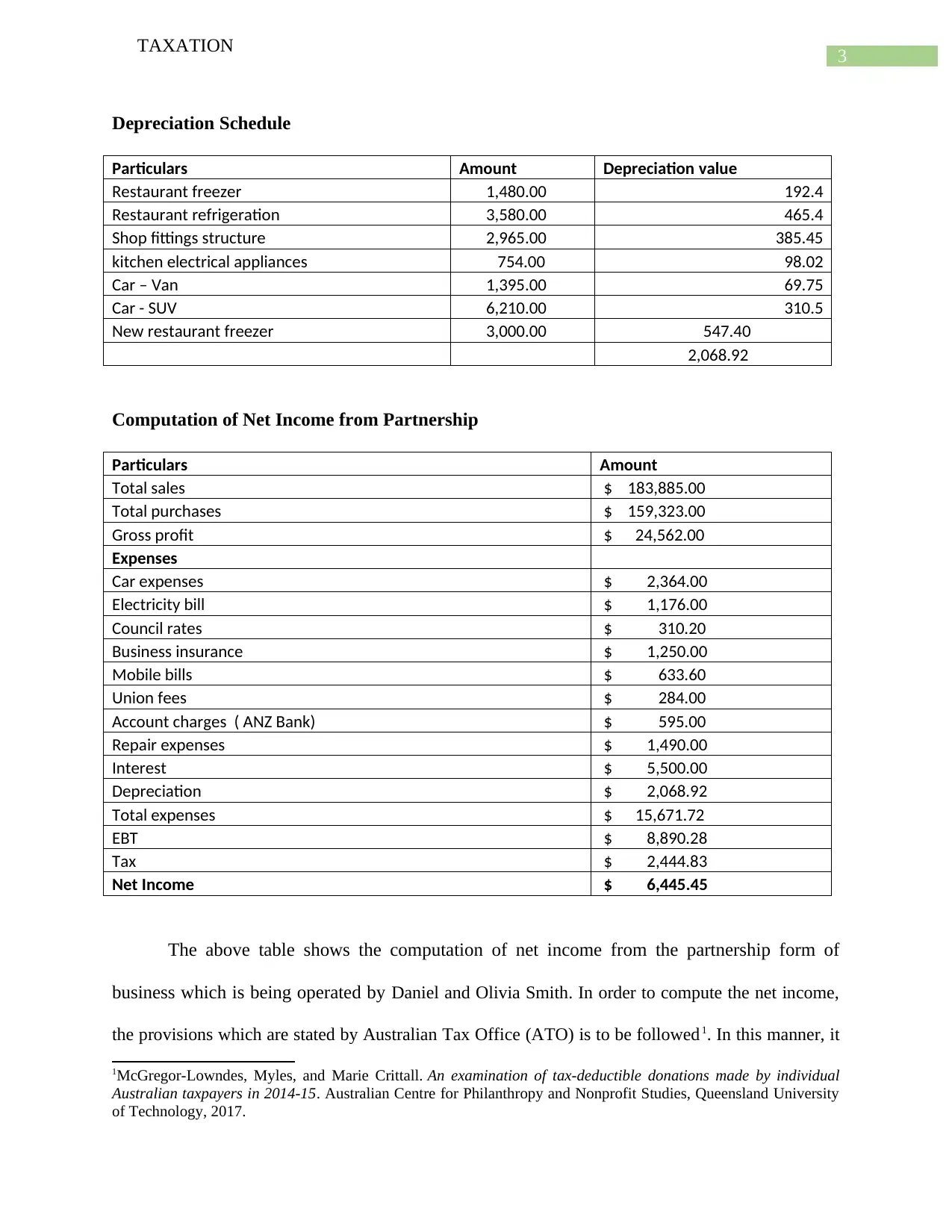
3
TAXATION
Depreciation Schedule
Particulars Amount Depreciation value
Restaurant freezer 1,480.00 192.4
Restaurant refrigeration 3,580.00 465.4
Shop fittings structure 2,965.00 385.45
kitchen electrical appliances 754.00 98.02
Car – Van 1,395.00 69.75
Car - SUV 6,210.00 310.5
New restaurant freezer 3,000.00 547.40
2,068.92
Computation of Net Income from Partnership
Particulars Amount
Total sales $ 183,885.00
Total purchases $ 159,323.00
Gross profit $ 24,562.00
Expenses
Car expenses $ 2,364.00
Electricity bill $ 1,176.00
Council rates $ 310.20
Business insurance $ 1,250.00
Mobile bills $ 633.60
Union fees $ 284.00
Account charges ( ANZ Bank) $ 595.00
Repair expenses $ 1,490.00
Interest $ 5,500.00
Depreciation $ 2,068.92
Total expenses $ 15,671.72
EBT $ 8,890.28
Tax $ 2,444.83
Net Income $ 6,445.45
The above table shows the computation of net income from the partnership form of
business which is being operated by Daniel and Olivia Smith. In order to compute the net income,
the provisions which are stated by Australian Tax Office (ATO) is to be followed1. In this manner, it
1McGregor-Lowndes, Myles, and Marie Crittall. An examination of tax-deductible donations made by individual
Australian taxpayers in 2014-15. Australian Centre for Philanthropy and Nonprofit Studies, Queensland University
of Technology, 2017.
TAXATION
Depreciation Schedule
Particulars Amount Depreciation value
Restaurant freezer 1,480.00 192.4
Restaurant refrigeration 3,580.00 465.4
Shop fittings structure 2,965.00 385.45
kitchen electrical appliances 754.00 98.02
Car – Van 1,395.00 69.75
Car - SUV 6,210.00 310.5
New restaurant freezer 3,000.00 547.40
2,068.92
Computation of Net Income from Partnership
Particulars Amount
Total sales $ 183,885.00
Total purchases $ 159,323.00
Gross profit $ 24,562.00
Expenses
Car expenses $ 2,364.00
Electricity bill $ 1,176.00
Council rates $ 310.20
Business insurance $ 1,250.00
Mobile bills $ 633.60
Union fees $ 284.00
Account charges ( ANZ Bank) $ 595.00
Repair expenses $ 1,490.00
Interest $ 5,500.00
Depreciation $ 2,068.92
Total expenses $ 15,671.72
EBT $ 8,890.28
Tax $ 2,444.83
Net Income $ 6,445.45
The above table shows the computation of net income from the partnership form of
business which is being operated by Daniel and Olivia Smith. In order to compute the net income,
the provisions which are stated by Australian Tax Office (ATO) is to be followed1. In this manner, it
1McGregor-Lowndes, Myles, and Marie Crittall. An examination of tax-deductible donations made by individual
Australian taxpayers in 2014-15. Australian Centre for Philanthropy and Nonprofit Studies, Queensland University
of Technology, 2017.
Paraphrase This Document
Need a fresh take? Get an instant paraphrase of this document with our AI Paraphraser
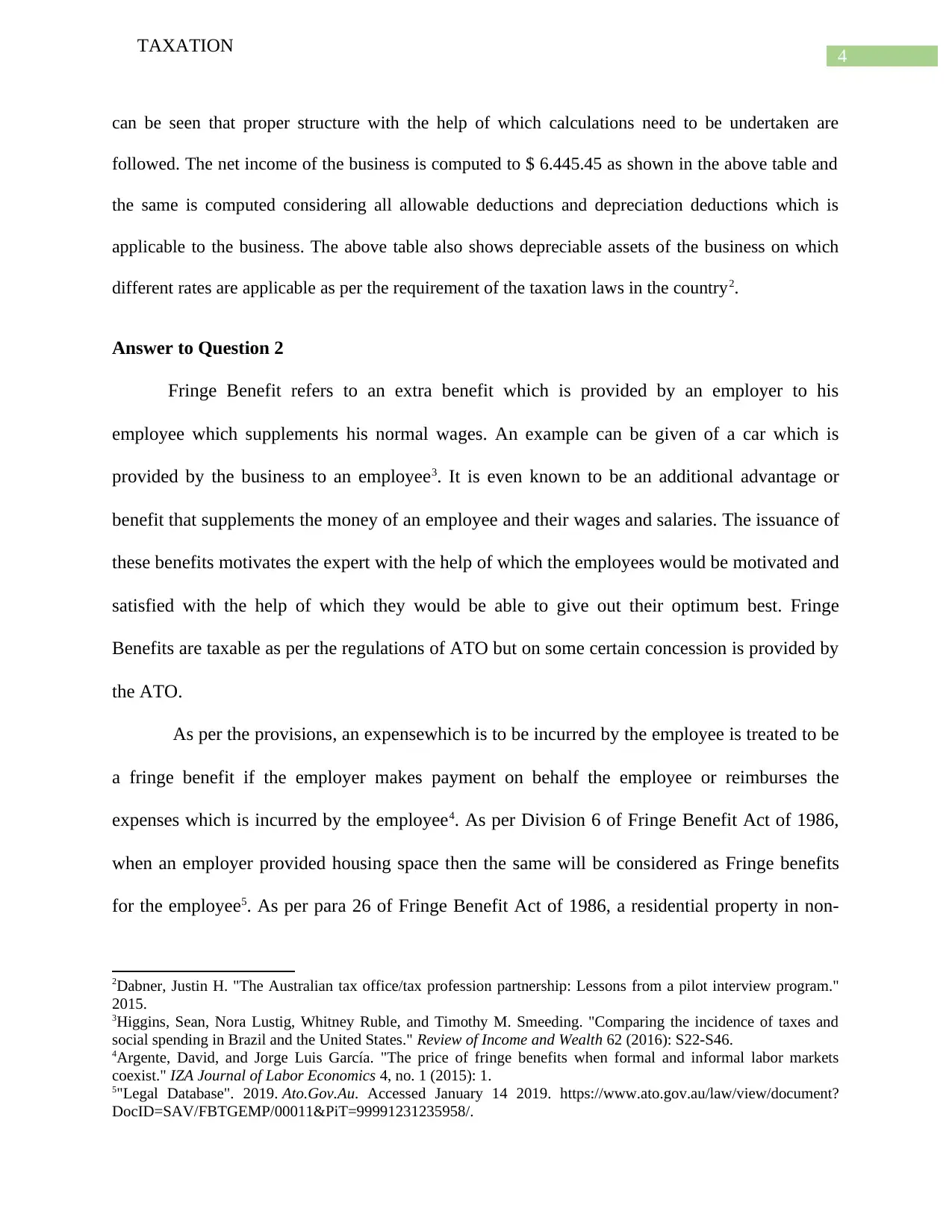
4
TAXATION
can be seen that proper structure with the help of which calculations need to be undertaken are
followed. The net income of the business is computed to $ 6.445.45 as shown in the above table and
the same is computed considering all allowable deductions and depreciation deductions which is
applicable to the business. The above table also shows depreciable assets of the business on which
different rates are applicable as per the requirement of the taxation laws in the country2.
Answer to Question 2
Fringe Benefit refers to an extra benefit which is provided by an employer to his
employee which supplements his normal wages. An example can be given of a car which is
provided by the business to an employee3. It is even known to be an additional advantage or
benefit that supplements the money of an employee and their wages and salaries. The issuance of
these benefits motivates the expert with the help of which the employees would be motivated and
satisfied with the help of which they would be able to give out their optimum best. Fringe
Benefits are taxable as per the regulations of ATO but on some certain concession is provided by
the ATO.
As per the provisions, an expensewhich is to be incurred by the employee is treated to be
a fringe benefit if the employer makes payment on behalf the employee or reimburses the
expenses which is incurred by the employee4. As per Division 6 of Fringe Benefit Act of 1986,
when an employer provided housing space then the same will be considered as Fringe benefits
for the employee5. As per para 26 of Fringe Benefit Act of 1986, a residential property in non-
2Dabner, Justin H. "The Australian tax office/tax profession partnership: Lessons from a pilot interview program."
2015.
3Higgins, Sean, Nora Lustig, Whitney Ruble, and Timothy M. Smeeding. "Comparing the incidence of taxes and
social spending in Brazil and the United States." Review of Income and Wealth 62 (2016): S22-S46.
4Argente, David, and Jorge Luis García. "The price of fringe benefits when formal and informal labor markets
coexist." IZA Journal of Labor Economics 4, no. 1 (2015): 1.
5"Legal Database". 2019. Ato.Gov.Au. Accessed January 14 2019. https://www.ato.gov.au/law/view/document?
DocID=SAV/FBTGEMP/00011&PiT=99991231235958/.
TAXATION
can be seen that proper structure with the help of which calculations need to be undertaken are
followed. The net income of the business is computed to $ 6.445.45 as shown in the above table and
the same is computed considering all allowable deductions and depreciation deductions which is
applicable to the business. The above table also shows depreciable assets of the business on which
different rates are applicable as per the requirement of the taxation laws in the country2.
Answer to Question 2
Fringe Benefit refers to an extra benefit which is provided by an employer to his
employee which supplements his normal wages. An example can be given of a car which is
provided by the business to an employee3. It is even known to be an additional advantage or
benefit that supplements the money of an employee and their wages and salaries. The issuance of
these benefits motivates the expert with the help of which the employees would be motivated and
satisfied with the help of which they would be able to give out their optimum best. Fringe
Benefits are taxable as per the regulations of ATO but on some certain concession is provided by
the ATO.
As per the provisions, an expensewhich is to be incurred by the employee is treated to be
a fringe benefit if the employer makes payment on behalf the employee or reimburses the
expenses which is incurred by the employee4. As per Division 6 of Fringe Benefit Act of 1986,
when an employer provided housing space then the same will be considered as Fringe benefits
for the employee5. As per para 26 of Fringe Benefit Act of 1986, a residential property in non-
2Dabner, Justin H. "The Australian tax office/tax profession partnership: Lessons from a pilot interview program."
2015.
3Higgins, Sean, Nora Lustig, Whitney Ruble, and Timothy M. Smeeding. "Comparing the incidence of taxes and
social spending in Brazil and the United States." Review of Income and Wealth 62 (2016): S22-S46.
4Argente, David, and Jorge Luis García. "The price of fringe benefits when formal and informal labor markets
coexist." IZA Journal of Labor Economics 4, no. 1 (2015): 1.
5"Legal Database". 2019. Ato.Gov.Au. Accessed January 14 2019. https://www.ato.gov.au/law/view/document?
DocID=SAV/FBTGEMP/00011&PiT=99991231235958/.
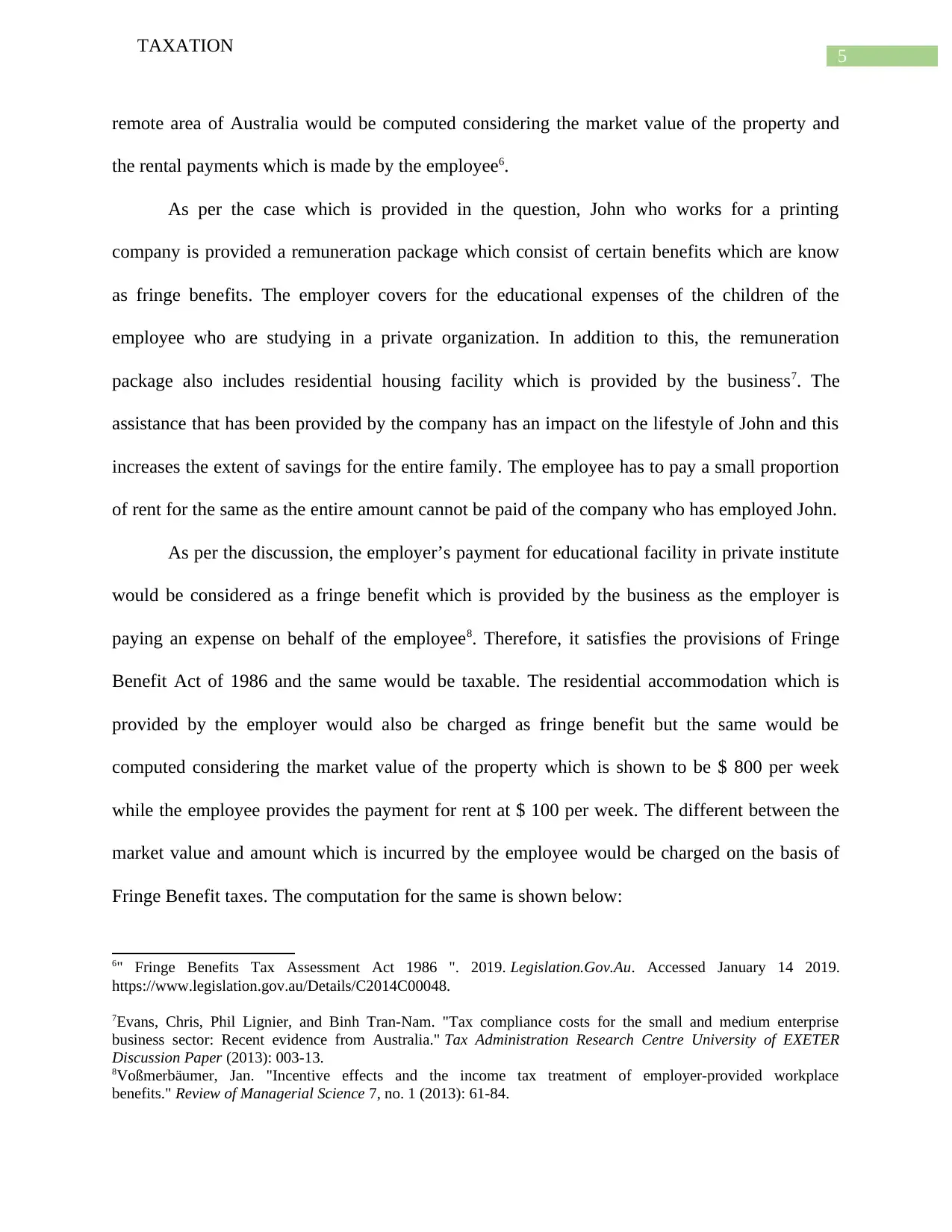
5
TAXATION
remote area of Australia would be computed considering the market value of the property and
the rental payments which is made by the employee6.
As per the case which is provided in the question, John who works for a printing
company is provided a remuneration package which consist of certain benefits which are know
as fringe benefits. The employer covers for the educational expenses of the children of the
employee who are studying in a private organization. In addition to this, the remuneration
package also includes residential housing facility which is provided by the business7. The
assistance that has been provided by the company has an impact on the lifestyle of John and this
increases the extent of savings for the entire family. The employee has to pay a small proportion
of rent for the same as the entire amount cannot be paid of the company who has employed John.
As per the discussion, the employer’s payment for educational facility in private institute
would be considered as a fringe benefit which is provided by the business as the employer is
paying an expense on behalf of the employee8. Therefore, it satisfies the provisions of Fringe
Benefit Act of 1986 and the same would be taxable. The residential accommodation which is
provided by the employer would also be charged as fringe benefit but the same would be
computed considering the market value of the property which is shown to be $ 800 per week
while the employee provides the payment for rent at $ 100 per week. The different between the
market value and amount which is incurred by the employee would be charged on the basis of
Fringe Benefit taxes. The computation for the same is shown below:
6" Fringe Benefits Tax Assessment Act 1986 ". 2019. Legislation.Gov.Au. Accessed January 14 2019.
https://www.legislation.gov.au/Details/C2014C00048.
7Evans, Chris, Phil Lignier, and Binh Tran-Nam. "Tax compliance costs for the small and medium enterprise
business sector: Recent evidence from Australia." Tax Administration Research Centre University of EXETER
Discussion Paper (2013): 003-13.
8Voßmerbäumer, Jan. "Incentive effects and the income tax treatment of employer-provided workplace
benefits." Review of Managerial Science 7, no. 1 (2013): 61-84.
TAXATION
remote area of Australia would be computed considering the market value of the property and
the rental payments which is made by the employee6.
As per the case which is provided in the question, John who works for a printing
company is provided a remuneration package which consist of certain benefits which are know
as fringe benefits. The employer covers for the educational expenses of the children of the
employee who are studying in a private organization. In addition to this, the remuneration
package also includes residential housing facility which is provided by the business7. The
assistance that has been provided by the company has an impact on the lifestyle of John and this
increases the extent of savings for the entire family. The employee has to pay a small proportion
of rent for the same as the entire amount cannot be paid of the company who has employed John.
As per the discussion, the employer’s payment for educational facility in private institute
would be considered as a fringe benefit which is provided by the business as the employer is
paying an expense on behalf of the employee8. Therefore, it satisfies the provisions of Fringe
Benefit Act of 1986 and the same would be taxable. The residential accommodation which is
provided by the employer would also be charged as fringe benefit but the same would be
computed considering the market value of the property which is shown to be $ 800 per week
while the employee provides the payment for rent at $ 100 per week. The different between the
market value and amount which is incurred by the employee would be charged on the basis of
Fringe Benefit taxes. The computation for the same is shown below:
6" Fringe Benefits Tax Assessment Act 1986 ". 2019. Legislation.Gov.Au. Accessed January 14 2019.
https://www.legislation.gov.au/Details/C2014C00048.
7Evans, Chris, Phil Lignier, and Binh Tran-Nam. "Tax compliance costs for the small and medium enterprise
business sector: Recent evidence from Australia." Tax Administration Research Centre University of EXETER
Discussion Paper (2013): 003-13.
8Voßmerbäumer, Jan. "Incentive effects and the income tax treatment of employer-provided workplace
benefits." Review of Managerial Science 7, no. 1 (2013): 61-84.
⊘ This is a preview!⊘
Do you want full access?
Subscribe today to unlock all pages.

Trusted by 1+ million students worldwide
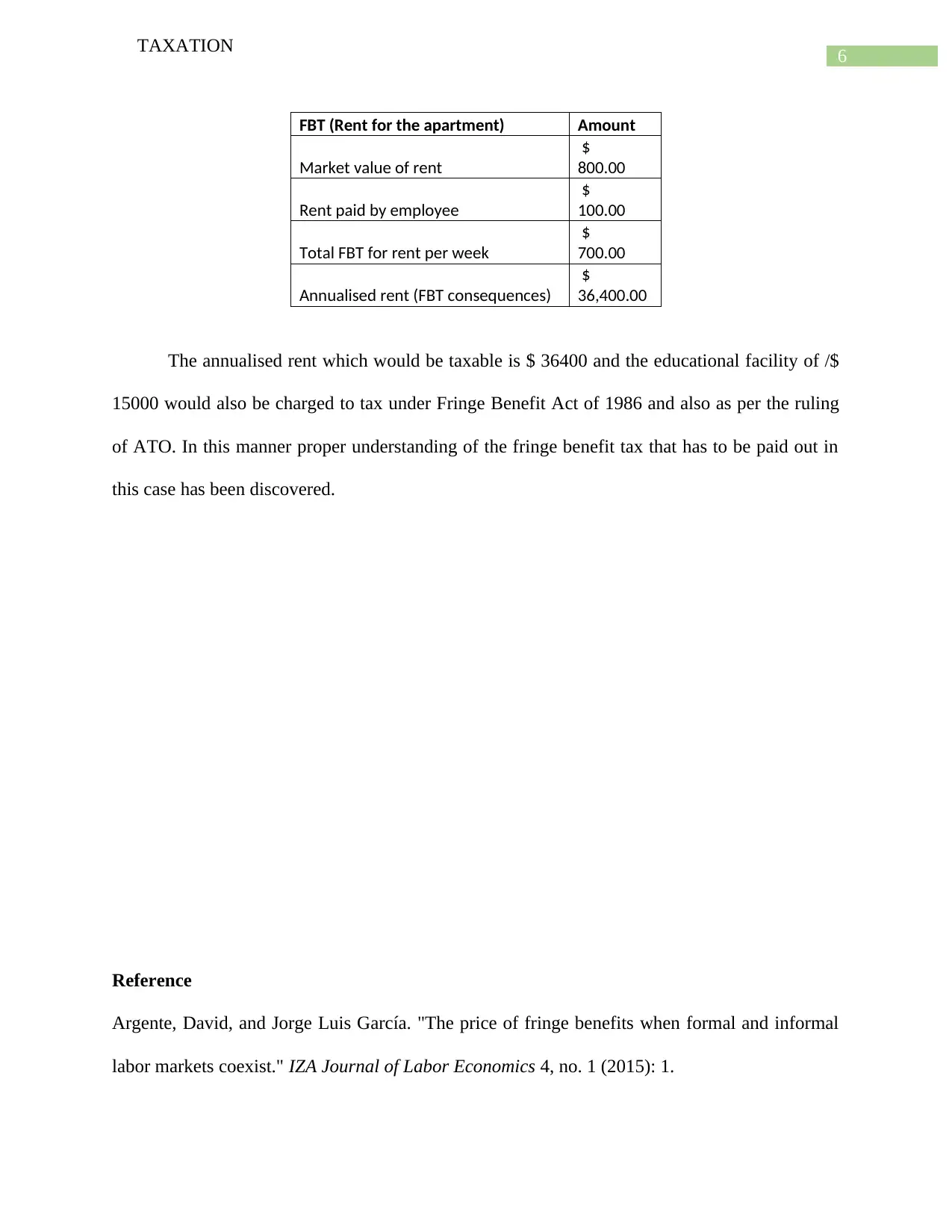
6
TAXATION
FBT (Rent for the apartment) Amount
Market value of rent
$
800.00
Rent paid by employee
$
100.00
Total FBT for rent per week
$
700.00
Annualised rent (FBT consequences)
$
36,400.00
The annualised rent which would be taxable is $ 36400 and the educational facility of /$
15000 would also be charged to tax under Fringe Benefit Act of 1986 and also as per the ruling
of ATO. In this manner proper understanding of the fringe benefit tax that has to be paid out in
this case has been discovered.
Reference
Argente, David, and Jorge Luis García. "The price of fringe benefits when formal and informal
labor markets coexist." IZA Journal of Labor Economics 4, no. 1 (2015): 1.
TAXATION
FBT (Rent for the apartment) Amount
Market value of rent
$
800.00
Rent paid by employee
$
100.00
Total FBT for rent per week
$
700.00
Annualised rent (FBT consequences)
$
36,400.00
The annualised rent which would be taxable is $ 36400 and the educational facility of /$
15000 would also be charged to tax under Fringe Benefit Act of 1986 and also as per the ruling
of ATO. In this manner proper understanding of the fringe benefit tax that has to be paid out in
this case has been discovered.
Reference
Argente, David, and Jorge Luis García. "The price of fringe benefits when formal and informal
labor markets coexist." IZA Journal of Labor Economics 4, no. 1 (2015): 1.
Paraphrase This Document
Need a fresh take? Get an instant paraphrase of this document with our AI Paraphraser
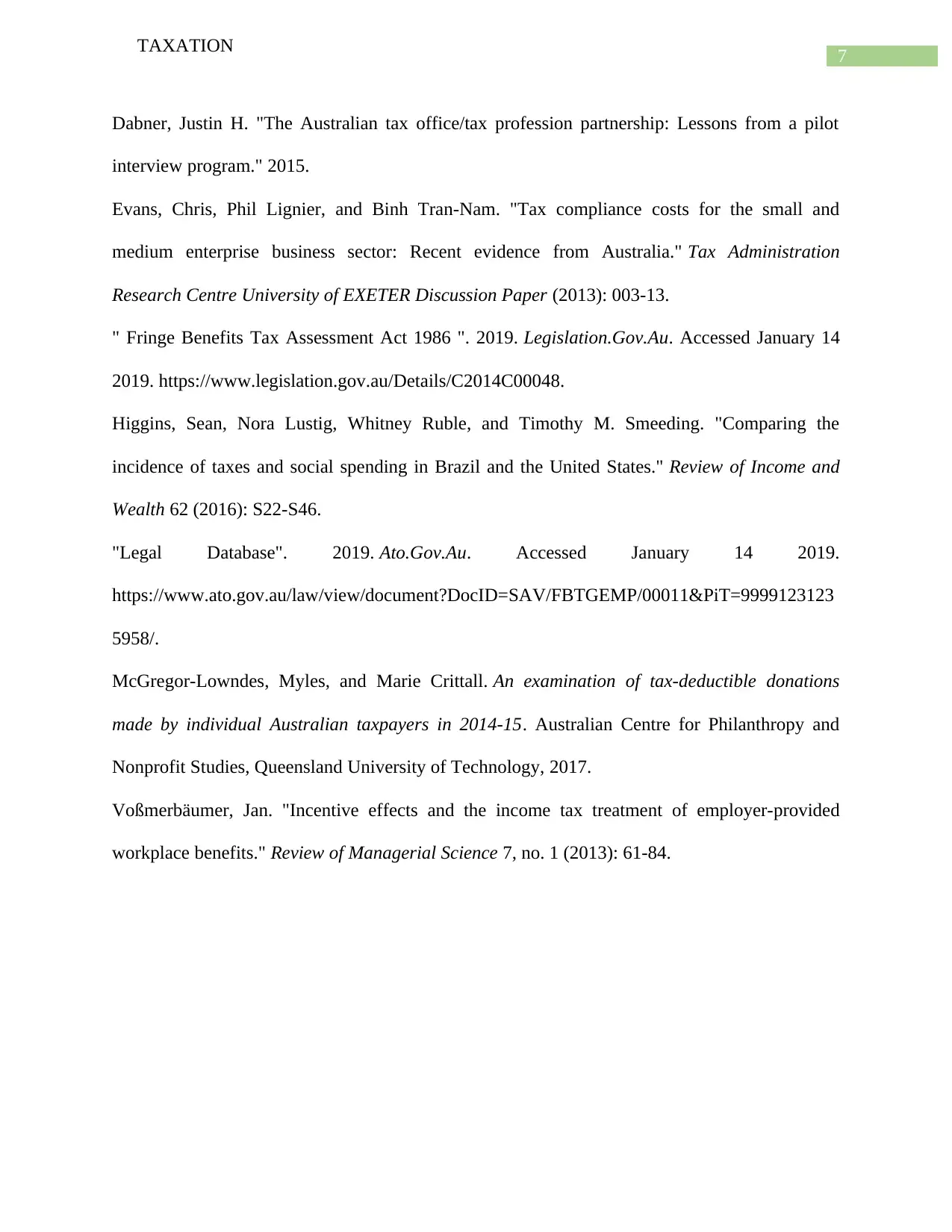
7
TAXATION
Dabner, Justin H. "The Australian tax office/tax profession partnership: Lessons from a pilot
interview program." 2015.
Evans, Chris, Phil Lignier, and Binh Tran-Nam. "Tax compliance costs for the small and
medium enterprise business sector: Recent evidence from Australia." Tax Administration
Research Centre University of EXETER Discussion Paper (2013): 003-13.
" Fringe Benefits Tax Assessment Act 1986 ". 2019. Legislation.Gov.Au. Accessed January 14
2019. https://www.legislation.gov.au/Details/C2014C00048.
Higgins, Sean, Nora Lustig, Whitney Ruble, and Timothy M. Smeeding. "Comparing the
incidence of taxes and social spending in Brazil and the United States." Review of Income and
Wealth 62 (2016): S22-S46.
"Legal Database". 2019. Ato.Gov.Au. Accessed January 14 2019.
https://www.ato.gov.au/law/view/document?DocID=SAV/FBTGEMP/00011&PiT=9999123123
5958/.
McGregor-Lowndes, Myles, and Marie Crittall. An examination of tax-deductible donations
made by individual Australian taxpayers in 2014-15. Australian Centre for Philanthropy and
Nonprofit Studies, Queensland University of Technology, 2017.
Voßmerbäumer, Jan. "Incentive effects and the income tax treatment of employer-provided
workplace benefits." Review of Managerial Science 7, no. 1 (2013): 61-84.
TAXATION
Dabner, Justin H. "The Australian tax office/tax profession partnership: Lessons from a pilot
interview program." 2015.
Evans, Chris, Phil Lignier, and Binh Tran-Nam. "Tax compliance costs for the small and
medium enterprise business sector: Recent evidence from Australia." Tax Administration
Research Centre University of EXETER Discussion Paper (2013): 003-13.
" Fringe Benefits Tax Assessment Act 1986 ". 2019. Legislation.Gov.Au. Accessed January 14
2019. https://www.legislation.gov.au/Details/C2014C00048.
Higgins, Sean, Nora Lustig, Whitney Ruble, and Timothy M. Smeeding. "Comparing the
incidence of taxes and social spending in Brazil and the United States." Review of Income and
Wealth 62 (2016): S22-S46.
"Legal Database". 2019. Ato.Gov.Au. Accessed January 14 2019.
https://www.ato.gov.au/law/view/document?DocID=SAV/FBTGEMP/00011&PiT=9999123123
5958/.
McGregor-Lowndes, Myles, and Marie Crittall. An examination of tax-deductible donations
made by individual Australian taxpayers in 2014-15. Australian Centre for Philanthropy and
Nonprofit Studies, Queensland University of Technology, 2017.
Voßmerbäumer, Jan. "Incentive effects and the income tax treatment of employer-provided
workplace benefits." Review of Managerial Science 7, no. 1 (2013): 61-84.
1 out of 8
Related Documents
Your All-in-One AI-Powered Toolkit for Academic Success.
+13062052269
info@desklib.com
Available 24*7 on WhatsApp / Email
![[object Object]](/_next/static/media/star-bottom.7253800d.svg)
Unlock your academic potential
Copyright © 2020–2025 A2Z Services. All Rights Reserved. Developed and managed by ZUCOL.





